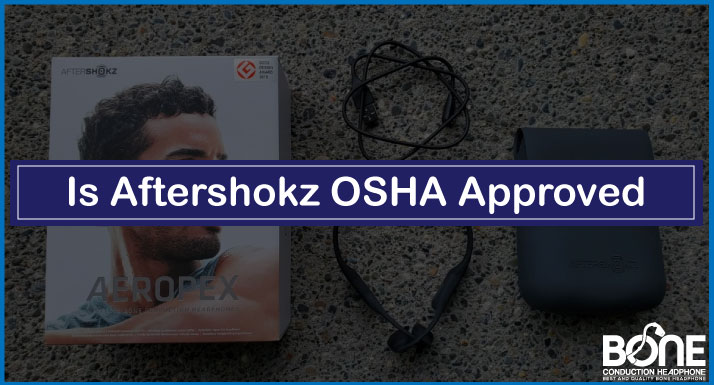Regarding occupational safety, it is crucial to ensure that employees have access to the right tools and equipment. While, bone-conduction headphones provide you with multiple benefits, with my personal favorite Aftershokz leading the way, employers’ concerns have emerged regarding the Occupational Safety and Health Administration’s (OSHA) approval of Aftershokz products.
In this article, we will dive deep into workplace safety and explore whether Aftershokz headphones meet the strict OSHA guidelines, providing clarity for those seeking a safe and efficient audio solution in professional environments.
Is Aftershokz OSHA Approved?
Aftershokz headphones, like other bone-conduction headphones, are not directly approved by OSHA. It’s important to note that OSHA does not register, approve, or endorse any specific commercial products or services. This means that claims made by manufacturers stating their products are “OSHA approved” or “OSHA compliant” are not accurate.
However, OSHA has set rules regarding safety standards in the workplace, including noise exposure and hearing protection and bone conduction headphones can help to execute that.
While they offer certain advantages for workplace safety including situational awareness, it is crucial for employers and individuals to assess and mitigate any potential risks associated with their use in specific work environments.
Does OSHA Allow Bone Conduction Headphones?
While bone-conduction headphones are not explicitly prohibited by OSHA, there are no specific regulations that approve them either. Furthermore, OSHA issued a warning in September 2019 regarding the use of headphones in the workplace, highlighting the potential safety hazards they can pose.
Since listening to music can impair one’s ability to hear important sounds in the surrounding environment. This can be particularly risky in active construction sites and outdoor settings where machinery, heavy equipment, and vehicles are present.
Moreover, these are the places where struck-by hazards are more common and it is one of the leading causes of death of employees, according to OSHA stats.
Therefore, as a precautionary measure, it is generally recommended to avoid wearing headphones in situations where safety is crucial, such as on construction sites or while walking and running outdoors, especially near roads.
Though in such cases, bone conduction headphones may offer a safer alternative to traditional headphones, as they allow for ambient sounds to be heard while still providing audio playback.
Is loud music an OSHA violation?
Certainly! Loud music in the workplace can potentially violate OSHA’s regulations, which aim to protect workers from excessive noise exposure. The agency sets a permissible exposure limit (PEL) of 85 decibels (dB) averaged over an 8-hour workday. Exposure to noise levels above this limit can result in hearing loss and other health issues.
As per the Centers for Disease Control (CDC), around 22 million employees are at risk for this noise pollution at their workplaces. Therefore, if loud music exceeds the permissible noise levels, employers are obligated to take action. This involves providing hearing protection devices and conducting regular noise monitoring and employee training.
Furthermore, OSHA also emphasizes the need for a hearing conservation program, designed to prevent hearing damage. Overall, being compliant with these regulations is essential to safeguard your workers’ hearing health.
What does OSHA say about headphones?
While OSHA does not outright prohibit the use of headphones in the workplace. However, they have issued a general warning about the potential safety hazards associated with wearing headphones in certain work environments.
They caution that listening to music or other audio sources through headphones can impair your ability to hear important sounds in the surrounding environment. This can pose risks where situational awareness is critical for worker safety.
What is the OSHA volume for music?
OSHA’s standard for occupational noise exposure in the general industry permits a level of 90 decibels (dBA) for an eight-hour exposure, with allowances for higher levels over shorter durations. If music exceeds this limit and poses a risk of hearing damage, employers are obligated to implement protective measures for workers.
Can bone conduction damage hearing?
Bone conduction itself does not damage hearing. However, if the sound being transmitted through bone conduction is too loud or exceeds safe noise levels, it can still cause hearing damage. The key is to ensure that the audio levels are within safe limits.
Conclusion
While from the article, it has been clear that Aftershokz headphones or any other commercial product aren’t directly certified by OSHA neither it has any rules to ban such headphone usage at the workplace. Though OSHA has rules for noise reduction and the music volume couldn’t exceed its permissible exposure limits for the protection of workers from potential hearing damage in the workplace.
FAQs
Why wear bone-conduction headphones?
Bone conduction headphones are a joy for those who suffer from various hearing impairments. Since it works by transmitting the sound vibrations through skull bones, skipping the eardrums, directly into the inner ear to decode by the brain. However, people with normal hearing can use them for commuting and doing athletic activities.
At what decibel is hearing damaged?
Loud noises above 120 dB will instantly damage your hearing while sound levels above 70dB will cause debilitating effects in the long run if you listen to it for prolonged periods of time.

